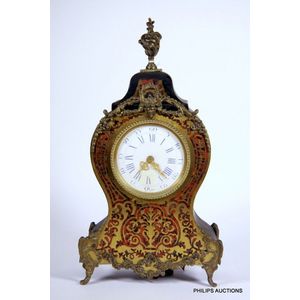French Boulle Style Mantle Clock, Early 20th Century
You must be a subscriber, and be logged in to view price and dealer details.
Subscribe Now to view actual auction price for this item
When you subscribe, you have the option of setting the currency in which to display prices to $Au, $US, $NZ or Stg.
- Foliate - Decorated with leaves or leaf-like forms.
- Pagoda Top - A shape based loosely on that of a Chinese pagoda, that is, pyramidal with sloped sides and a top cap. However there are many variations on the basic shape from a relatively flat pagoda to a tall pagoda with almost parallel concave sides to a true pagoda shape. As found on a pagoda, the pagoda top is often surmounted by a fancy finial. The pagoda top is most frequently found on the hoods of 18th century long case clocks, and on bracket clocks, and sometimes on Chinese Chippendale style furniture.
- Gilding - Gilding is a method of ornamentation whereby a thin sheet of gold metal is applied to items made of wood, leather, ceramics, glass and silver for decorative purposes.
For furniture including mirrors, the sheet of gold is usually applied over a coating of gesso. Gesso is a mixture of plaster of Paris and gypsum mixed with water and then applied to the carved wooden frames of mirrors and picture frames as a base for applying the gold leaf. After numerous coats of gesso have been applied, allowed to dry and then sanded a coat of "bole", a usually red coloured mixture of clay and glue is brushed on and allowed to dry, after which the gold leaf is applied. Over time parts of the gilding will rub off so the base colour can be seen. In water gilding, this was generally a blue colour, while in oil gilding, the under layer was often yellow. In Victorian times, gilders frequently used red as a pigment beneath the gold leaf.
Metal was often gilded by a process known as fire gilding. Gold mixed with mercury was applied and heated, causing the mercury to evaporate, the long-term effect of which was to kill or disable the craftsman or woman from mercury poisoning. The pursuit of beauty has claimed many victims, not the least of which were the artists who made those pieces so highly sought after today. - Boulle - Boulle work is the name given to tortoiseshell and metal inlay using brass and sometimes silver, found on furniture and smaller wooden objects. It originated in Italy but was developed by Frenchman Andre Charles Boulle (1642 - 1732) under Louis XIV.
Boulle was appointed Royal Cainet Maker to Louis XIV and designed furniture and clockcases for the monarch.
In preparation, the tortoiseshell and metal were cut together following a design, using a fine fret saw.
In the application of the Boulle, the carcase of piece of furniture was covered with the tortoiseshell which in turn was inlaid with the matched designs in metal, which in turn was elaborately engraved.
The use of Boulle work furniture continued mainly in France until the 19th century. - A/f, as Inspected - The letters "A/F" or "as inspected" as part of a description is the cataloguer's shorthand for "all faults" or "as found", meaning the item has some type of damage or deficiency, it is of uncertain date or provenance, and/or that the seller takes no responsibility for the completeness of the item or the accuracy of the description.
This item has been included into following indexes:
Visually similar items

A scarlet-boulle and gilt metal mounted mantel clock in the Louis XV style 35 cm high

Late 19th century bracket clock enamelled numeral dial cased in simulated red tortoiseshell case all with ornate ormolu mounts

A rare Louis XV ormolu mounted red lacquer mantel clock by Edme-Jean Causard (1720-1780), circa 1760-70, the clock of waisted form, the ormolu finial depicting the Triumph of love above the porcelain Roman numeral dial with sun King pendulum, eight day cou

A large boulle and gilt bronze bracket clock, French, 19th century, 88 cm high
